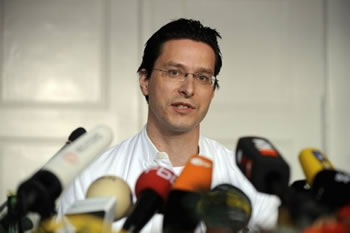"Berlin
Patient" Still HIV-free 4 Years after Bone Marrow Transplant
 |
 |
 |
 |
 |
 |
 |
| SUMMARY:
The "Berlin Patient" -- now known to be
Timothy Ray Brown -- remains free of any detectable
HIV in his blood, gut tissue, and other reservoir
sites 4 years after receiving a bone marrow transplant
containing stem cells from a donor with the CCR5-delta32
mutation, according to a report in the December
8, 2010 advance online edition of Blood.
These findings, his doctors say, "strongly
suggest that cure of HIV has been achieved in this
patient." |
|
 |
 |
 |
 |
 |
 |
 |
By
Liz Highleyman
This
year has seen an increased
emphasis on a cure for HIV, spurred in part by the proof-of-concept
offered by the "Berlin Patient," an HIV positive
man who needed a bone marrow transplant to treat leukemia.
HIV requires one of 2 co-receptors, CCR5 or CXCR4, to enter
human cells. Individuals with a natural genetic mutation known
as CCR5-delta32, who do not express CCR5 on their CD4 T-cells,
are resistant to HIV infection. Those who do become infected
may be "elite controllers" who maintain very low
viral load without antiretroviral
therapy (ART).
The Berlin Patient underwent leukemia treatment that involves
using potent chemotherapy to kill off immune cells -- which
eliminates the cancer -- and reconstituting the immune system
with donated hematopoietic stem cells, which differentiate
into all the different types of blood cells, including T-cells.
 |
|
Doctor
Gero Huetter of Berlin's University Hospital 'Charite,'
speaks to the press about the miraculous recovery
of his patient.
|
|
Gero
Hütter and his team at Charite-University Medicine
in Berlin searched the German bone marrow donor registry and
managed to find a donor who was not only a compatible match,
but also had a double or homozygous CCR5-delta32 mutation.
As
reported in the February
12, 2009, New England Journal of Medicine, after
the first transplant, researchers were unable to find any
evidence of HIV, even though the patient stopped taking ART.
He then received a second transplant from the same donor due
to a relapse of leukemia. In the latest report, Hütter
and colleagues provide an update on the patient's current
status.
In
every other known case to date, HIV remains in the body at
low levels despite ART, hidden in resting memory T-cells and
other viral reservoirs. When treatment is stopped, the virus
begins replicating anew, leading to viral load rebound.
The
Berlin Patient, however, shows no evidence of residual HIV
and has not experienced disease progression. His immune system
was successfully reconstituted, and now contains HIV-resistant
CCR5-delta32 cells, like those of the donor. Furthermore,
the researchers noted, "We found evidence for the replacement
of long-lived host tissue cells with donor-derived cells indicating
that the size of the viral reservoir has been reduced over
time."
"[O]ur results demonstrate successful CD4+ T-cell reconstitution
at the systemic level as well as in the largest immunologic
organ [the gut] following CCR5-delta32/delta32 stem cell transplant,
and additionally provide evidence for the reduction in the
size of the potential HIV reservoir over time," they
elaborated in their discussion.
CCR5-delta32 cells may not render a person completely resistant,
since some strains of HIV may still be able to use the alternate
CXCR4 co-receptor. The potent chemotherapy used in this case
to ablate or kill off the man's original immune cells may
have also played a role in the apparent eradication of HIV.
"Although
the recovered CD4+ T-cells are susceptible to infection with
[CXCR4] HIV infection, the patient remains without any evidence
for HIV infection since more than 3.5 years after discontinuation
of ART," the researchers concluded. "From these
results, it is reasonable to conclude that cure of HIV infection
has been achieved in this patient."
The
Patient Comes Out
Concurrent
with Hütter and colleagues' report in Blood, the Berlin
Patient revealed his identity in a profile in the December
8 online issue of the German magazine Stern.
According
to Google translation of the original article, Timothy Ray
Brown, 44, is an American citizen living long-term in Germany.
HIV positive since 1995, he developed leukemia in 2006. He
was initially treated with chemotherapy, but without sustained
response. Hütter -- who had little experience with HIV
but had heard about the CCR-delta32 resistance mutation --
decided to try an unprecedented experiment. The case will
go down in history as a milestone in the epidemic; not only
does Brown show no signs of HIV, he also is in long-term remission
from leukemia.
It is not possible, of course, to give every HIV positive
person a stem cell transplant. In addition to the great expense,
the ablation process can be fatal and there are too few CCR5-delta
32 donors to go around. But the Berlin Patient provides proof-of-concept
needed to move forward with related approaches now under study,
such as using
zinc finger gene therapy to delete CCR5 from hematopoietic
stem cells that are then returned to the body in the hope
of creating an HIV-resistant immune system.
Investigator affiliations: Department of Gastroenterology,
Infectious Diseases, and Rheumatology, Medical Clinic I, Campus
Benjamin Franklin, Charite-University Medicine Berlin, Germany;
Department of Hematology, Oncology, and Transfusion Medicine,
Medical Clinic III, Campus Benjamin Franklin, Charite-University
Medicine Berlin, Germany; Institute of Medical Virology, Helmut-Ruska-Haus,
Campus Mitte, Charite-University Medicine Berlin, Germany;
Institute of Pathology/Research Center ImmunoSciences (RCIS),
Campus Benjamin Franklin, Charite-University Medicine Berlin,
Germany.
12/14/10
Reference
K
Allers, G Hütter, J Hofmann, and others. Evidence for
the cure of HIV infection by CCR5delta32/delta32 stem cell
transplantation. Blood (Abstract).
December 8, 2010 (Epub ahead of print).
Other Source
The
Berlin Patient: Der Mann, der HIV besiegte (The man who defeated
HIV). Stern.
December 8, 2010.
